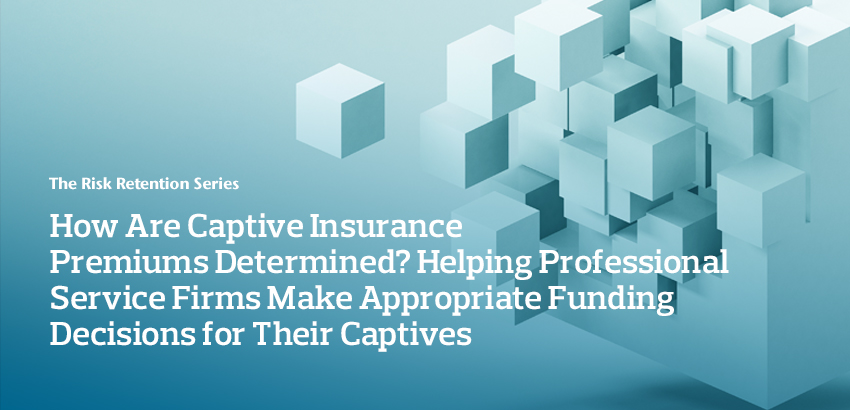Aon | Professional Services Practice
The risk retention series:
How Are Captive Insurance Premiums Determined?
Helping Professional Service Firms Make Appropriate Funding Decisions for Their Captives
Release Date: January 2022
The Professional Services Practice at Aon share insights to help firms navigate a hardening insurance market in the eighth article in a series exploring risk retention.
For a captive to achieve lasting success it must ensure that it is adequately funded. Its managers must be able to determine the suitable insurance premiums to charge their policyholders for the coverages provided while satisfying regulatory requirements. A captive’s actuary provides captive management with claims forecasting through actuarial risk analysis – information vital for discussions of funding and for optimizing program structure. These core principles are applicable for both single parent and group captives.
Components of a Premium
The captive, as an insurance company, must charge appropriate premium to policyholders in exchange for the obligation to pay the claims that arise from its insurance policies. In addition to paying claims, the captive insurer must also factor in other operational costs, such as general and administrative expenses and applicable taxes.

However, the captive insurer does benefit by investing the premiums it collects from the policyholders before making claim payments. As illustrated on the right, the captive insurer must ensure that the funds coming in (e.g., premiums and investment income) are adequate to cover its expenditures (e.g., claim payments and operating expense) and a return on capital:
Therefore, a typical actuarial premium calculation for an insurance policy could be viewed as the projected claims costs arising from the coverage provided (as determined through actuarial modelling), discounted by the time value of money for investment returns, plus operating expenses, and a profit margin to strengthen the captive’s capital position.
Premiums are the main source of income for a captive. At the onset, it may be more desirable to take a conservative view in premium funding to build sufficient capital such that the captive is able to pay claims and withstand unforeseen events. Managing the cost of claims over the long-term and year-on-year volatility in losses require adequate annual premium and a strong capital position. As a result, premium setting is an important exercise as the parent will typically seek to avoid large year-over-year premium swings and demands for unexpected capital injections when claims significantly exceed the captive’s cumulative retained earnings.
Underwriting Considerations
The captive’s actuary is critical in providing an actuarial premium calculation, but other judgmental aspects must be considered in conjunction to the actuarial model outputs when thinking about captive funding:
- The evolving nature of risk: actuarial models are typically fitted to historical claims, but if the captive management’s underwriting view of the prospective risk is evolving, either adversely or favorably, then it is reasonable to adjust funding amounts accordingly. Actuarial modelling results are also sensitive to underlying assumptions such as inflationary trend rates. Prudent funding may be appropriate at a higher percentile level than past experience suggests, for example, if the historical claim data is relatively sparse and understating the risks.
- The financial strength of captive: captive premium decisions should consider its capital levels. For example, a captive that is relatively immature and seeking to build up capital could choose a more conservative funding amounts (such as selecting a higher percentile level from the actuarial claims forecasting analysis) to benefit from the profit margin. Conversely, a well-established captive with a strong balance sheet may wish to select premiums using a more optimistic outlook as the captive’s goal would then be to break-even over the long-term rather than continue to build profits and capital.
- Comparison with commercial (re)insurance premiums: actuarial analysis of claims costs could also be compared to commercial premiums charged in the insurance market to assist in strategically selecting alternate program retentions and structures to minimize the total cost of risk for the parent firm. Actuarial analysis can also be used to assist in evaluating captive reinsurance purchasing options.
- Year-over-year volatility in premiums: the impact of large swings in the premium paid by the parent firm should also be considered by the captive. Such swings may be undesirable if the volatility impacts the yearly income of the parent firm or partnership in an unexpected manner.
Conclusion
The actuarial function is essential to the successful operation of a captive. It is key in assisting in the determination of appropriate premium for the insurance coverages being offered and in constructing an optimal program structure. Actuarial analysis is supplemented by other considerations, such as management’s underwriting view, the financial strength of the captive, as well as the prevailing commercial (re)insurance market conditions.
Contact
The Professional Services Practice at Aon values your feedback. If you have any comments or questions, please contact Henry Lim.
Henry Lim
Managing Director
Montreal

